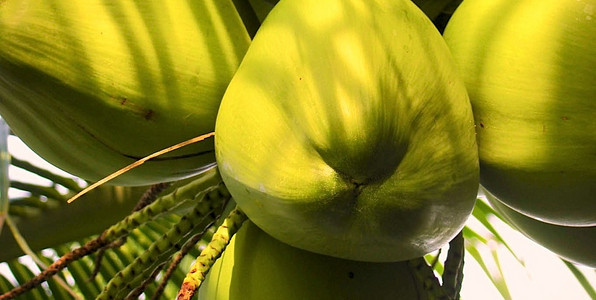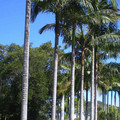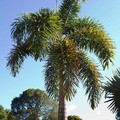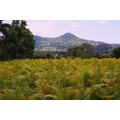Gallery
Click the thumbnails below to view image gallery:Humans have cultivated and used palms from the beginning of civilization. Date palms, for example, have been used by the middle-eastern settlements for over 5000 years. Other uses of palms include the harvesting or extraction of coconut, oils, syrups, ivory nuts, carnauba wax, rattan cane, raffia, and palm wood.
Other varieties of palms also provide, betel nut, heart of palm (used as a vegetable), nypa (a sap used to make vinegar), dragon's blood (a reddish resin which is used in the manufacture of medicines, varnish, and dyes), coir (which is a fiber that is comes from the shell of coconuts and has a multitude of applications), sago, palm wine (made from Jubaea or Chilean wine palm), and a host of other uses.
Palms are a great source of food in emergencies. For example, a little known fact is that the terminal bud of almost any palm is edible - both cooked and raw. The terminal bud is on the tip of the trunk and is enclosed by either a frown of leaves or a kind of sheathing.
In Australia, palm plantations, farms, as well as naturally growing palms provide coconuts, palm oil, palm oil seed, dates, edible cabbage, betelnut, sap, edible palm hearts, rattan, palm fruit, and several other types of lesser-known edible products.
The Australian fan palm (Livistona australis) has young tender leaves that are edible. The Walking stick palm (Linospadix monostachya) grows a fruit that is stringy, waxy, red, and pleasant to chew. The Cabbage palm (Livistona spp.) and Aconotophoneix spp have an edible cabbage.
The Buri Palm (Corypha) is an Australian palm whose leaves can grow to be 3 metres in diameter. This palm has a sap that is sugary and the buds are edible and tasty. Buri palm leaves and stem fibers are also used for making cord, rope, fishing line, bags, decorative pillows, hats, slippers, wallpaper, blinds, and hats.
The Açaí palm, though native to Central and South America, is now also found in various parts of Asia and is grown on farms and nurseries in Australia. In their original habitat of Central and South America they are cultivated primarily for their fruit. The fruit is similar in appearance to a grape though smaller and with less pulp. It is small and round and purplish in colour. The fruit is traditionally served with tapioca and can be made sugary or salty, depending on preference.
Another exotic dish is the Banga soup, which is also called palm nut soup. It is made from the palm fruit (Elaeis guineensis) by squeezing its sauce out. Banga soup traditionally comes from Nigeria but is becoming more and more popular all over the world including Australia.
Palm nut sauce is also made from this fruit and both these items are known to have high nutrition value. The sauce is made from palm fruit being boiled in water for about 20 minutes. This makes the pulp soft and the mixture is then pounded in a mortar. The resulting sauce is then strained.
Hearts of Palms is a delicacy that originated in Florida. The heart of the Sabal Palmetto palm, which is the state tree of Florida, is a delicacy and is extremely tender and delectable. This palm was originally known as "swamp cabbage." Hearts of Palms are popular throughout the world now. They have no cholesterol and are an excellent source for fiber.
By far, the most popular and versatile palm fruit in the world, and in Australia, is the coconut. They are large palms, which can grow up to thirty metres tall. They have many culinary as well as non-culinary uses. Virtually every part of the palms can be, and has been, utilized by humans since the very advent of civilization.
Coconuts are eaten in more ways than almost any other fruit. Coconut water is refreshing and highly nutritious (comprising of sugar, fiber, proteins, antioxidants, minerals, and vitamins) and is consumed around the world by all sections of society. Coconut endosperm or "flesh" has several uses in cooking and is, of course, a delicacy when eaten raw. Coconuts provide oil which itself has many uses in different parts of the world.
In botanical terms, the coconut fruit is a drupe and not a true nut. Coconut oil, milk, and flesh are used in the manufacturing of margarine, confectionaries, desserts, flour, butter, curries, and a host of other food items. In some parts of the world coconut roots are used varyingly as a dye, mouthwash, as well as a medicine for diarrhea.
In Australia, Coconuts grow commonly in the top end. They are also grown in the warmer protected coastal parts of northern New South Wales.
The Date Palm (Phoenix dactylifera) has feed the world for thousands of years and still does. It is different from the Canary Is Date, which appears down so many country town main streets. The fruiting Date Palm also grows well in Australia but only produces fruit in hot and dry areas.
The Wine palm also called the Wine and Jelly palm (Butia capitata) has a fruit that is very sweet like wine and jelly the fruit is about 3 to 4 cm's round with a seed inside about 1 to 2 cm's. It is delicious to eat but rodents also work this out. The trick is to pick before they do. The fruit is small with a short shelf life and is not suited to commercial farming.
<< Previous Madagascar, an Island of Palms | Back to Mullumbimby Palm Blog | Next >> Palm Fertilizer and Best Practices







